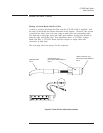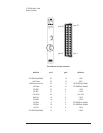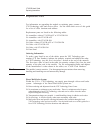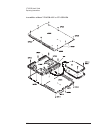
Diagnostics
The following describes a limited diagnostic program for the VT1432A, VT1433B
and VT1434A. It is to be run from an HP-UX host. The program is called
“hostdiag.” It can be found with the VT1432A Host Interface Software Library
at location /usr/e1432/bin.
location: /usr/e1432/bin
Usage: hostdiag [-hPsuvV] [-f file] [-L laddr] [-S slot] [-O list]
-h
Does a quick, partial test by bypassing the tests which involve downloading code
to the module.
-f file
Uses “file” as the source of code to download to the module instead of the
default sema.bin.
-L logical_addr
Specifies the logical address of the module to be tested. The default value is 8.
-O option_list
Tests the module against a list model/options. For example -O
“E1432,1DE,AYF” tests the module as an 8-channel VT1432A with the
tachometer option. Without this option, hostdiag only tests what it finds present.
Hardware which has failed in such a way that it appears to be absent will not be
detected without this option.
-P
Prints only a pass/fail message - no diagnostic printouts.
-s
Additionally runs the “standard input/output” tests. Sources finish testing with
1V
PK
, 1 kHz sine on each output for manual verification of output functionality.
Input testing (both VT1432A and VT1433B inputs and the Tachometer input)
assumes 1 V
PK
, 1 kHz sine input on each channel. This allows testing of
additional portions of the signal path which inaccessible from the internal tests.
-S vxi_slot
Test the module in the vxi slot, vxi_slot. Default is to test the module at logical
address 8.
VT1433B User's Guide
Troubleshooting the VT1433B
9-2


















